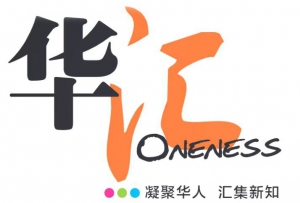印度婚礼的8个为什么?
偷新郎的鞋,把新娘装篮,家人亲友深夜到街上歌舞?
文│Sukanya Pushkarna 图│作者提供 iStock
这里说的印度婚礼传统,大多源自仍存在童婚的年代。一般上少女初潮后便可结婚,被父母许诺给邻近或遥远村庄的成年男子。婚礼上不仅有男女双方的家人亲戚,有时全村人都会到场观礼见证。新娘母亲的娘家也会参与,提供经济支持,因此很多婚礼仪式由新娘的舅舅带领。现今的新郎新娘大多在婚前已彼此熟悉,婚礼不再有神秘感,而是甜蜜的祝福。至今,传统婚俗有些还保留着,有些已渐行渐远。
1. 为什么新娘的姐妹要偷新郎的鞋?
婚礼仪式中最有趣的环节之一,是新郎必须脱掉鞋子才能坐上婚礼台。这时,新娘的姐妹们会把新郎的鞋子藏起来,然后和新姐夫经过多番谈判,讨价还价后才归还。在两个家庭很少有机会见面和了解的情况下,这个有趣的游戏给了新娘的弟弟妹妹一个接近新姐夫的机会。
2.为什么有些印度新娘,需用篮子抬到婚礼仪式台上?
在过去的一些南印度婚礼中,特别是在喀拉拉邦举行的婚礼,如果新娘在法定结婚年龄前出嫁,须由她的舅舅亲自用篮子把她抬到仪式台上。如今,印度女孩必须满18岁才准结婚,但抬新娘这个古老的仪式还是保留着。
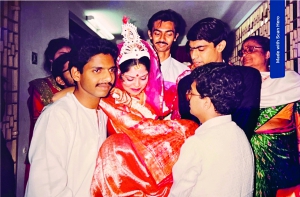
3. 为什么婚礼前一天,一对新人要在身上涂抹姜黄膏?
姜黄在印度社会扮演着重要的角色,它象征着纯洁和健康,由于姜黄对皮肤特别好,赋予肌肤健康光泽,所以在印度婚礼前,新人都会进行涂抹姜黄仪式(haldi ceremony),具有“吉祥”与“神圣之光”的象征。此外,还要使用一种含有姜黄素的磨砂按摩身体,这将有助于新人舒缓焦虑与紧张,在婚礼上保持冷静情绪。简单的说,整个姜黄仪式实则是一个净化仪式,意味着新郎新娘经过净化后,将一起迎向新的开始。
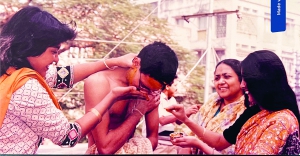
4. 为什么新郎的姐妹们在婚礼开始前,要喂一匹白马?
在北印度的婚礼中,新郎通常骑着白马前往婚礼场地。这是一个有着数百年历史的传统。在今日,他们只是按照“骑白马”的传统,在婚礼中作短距离的游行。新郎的姐妹们喂母马,是为了确保马匹在嘈杂的音乐和舞蹈中有足够的精力,安稳地载着新郎,不会分心。
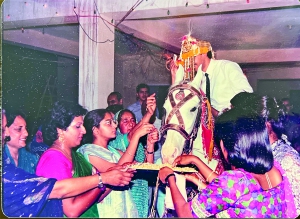
5. 为什么一对新人的家人半夜出门,唱歌又跳舞?
锡克教徒的婚礼前夕,双方家人会通宵达旦不眠不休,并在凌晨时分庆祝Jago(唤醒)仪式。新人的姨妈或母亲把黄铜或铜容器顶在头上走,而另一名妇女则会用一根系着铃铛的长棍子去摇晃它。大伙儿一起载歌载舞,热热闹闹地从一家到另一家唤醒他人,以提醒亲友传统的婚礼仪式就在隔天举行。
6. 为什么新娘一进新家就把饭锅推倒?
在这个吉祥的日子里,一对新人会被视为代表印度教神毗湿奴和他的配偶财富女神拉克希米。当新娘离开娘家时,会将米饭向后抛向娘家门,象征即使在出嫁,娘家依然财富不减。
她抵达夫家后,在入屋前需用右脚将装满米饭的容器往屋内推倒,象征新娘将带来财富。有时候,新娘也会用脚踏沾盘中盛满染红的牛奶,然后轻步在屋内各处留下她的脚印,象征着财神爷来访,会给这个家带来很多财富。
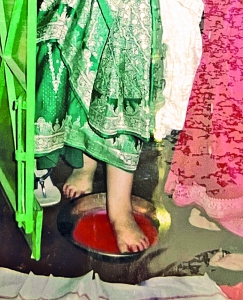
7. 为什么有些新郎新娘到了婚宴地点时会捂脸?
从前,新郎新娘在婚礼上才第一次见面,新娘会用面纱或槟榔叶遮脸。孟加拉新娘倾向于遵循这种仪式,
至今仍是一样。至于北印度,特别是旁遮普的新郎,则会在头饰上加上遮脸的花帘,以免新郎遭到邪恶的目光,只有当新娘在他面前时,花帘才会被拉开,好让一对新人对看。
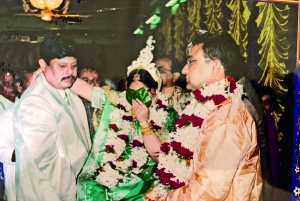
8. 为什么从前的婚礼通常在凌晨举行?
印度人相信占星术,会在男女双方的星座匹配后安排婚姻,婚礼时间也参考占星图。在凌晨时间行婚礼,是由于男方从自己的村子去到新娘的村子后,隔天还要返回,因此凌晨的吉时最为方便。也有些地区相信,日出时间是最好的时间。
Indian weddings explained
1. Why do the bride’s sisters steal the groom’s shoes?
The groom has to take off his shoes to get on the wedding dais. At this point, the bride’s sisters will grab and hide them, only returning them after much negotiation for a sum of money and other gifts.
2. Why are some brides carried in a basket to the wedding ceremony?
In some South Indian weddings in the past, a very young child bride may have had to be carried. In Kerala, the bride’s uncle would typically carry her to the ceremonial dais in a basket. Today, brides must be 18, so this ritual is just a remnant of a bygone era.
3. Why do newlyweds apply turmeric paste on their bodies the day before their wedding?
Turmeric gives the skin a healthy glow, so the newlyweds perform an auspicious haldi ceremony before their wedding. The accompanying massage is done with a scrub that contains curcumin, which helps to soothe anxiety and tension. This is a purification ceremony that ushers in a new beginning for the bride and groom.
4. Why do the bridegroom’s sisters feed a white horse before the wedding?
In North Indian weddings of the past, the groom sometimes travelled to the wedding venue on horseback. Today, they follow this tradition by doing a short procession nearby. The groom’s sisters feed the mare to ensure that it has enough energy to carry the groom safely during the loud music and dancing.
5. Why do the couple’s families go out in the early hours of the wedding day to sing and dance?
The day before a Sikh wedding, both families celebrate the jago (awakening) ceremony in the early hours. The aunts or mothers of the newlyweds walk with a brass or copper container over their heads, while a woman shakes it with a long stick tied with a bell. Everyone sings and dances, waking those from other houses. This is a reminder to relatives and friends that the wedding ceremony is taking place the next day.
6. Why does the bride overturn a pot of rice with her toes as soon as she enters her new home?
On this auspicious day, the newlyweds are seen to represent the Hindu god Vishnu and his consort Lakshmi, the goddess of wealth. When the bride leaves her family, she scatters rice behind her, symbolising that her family will continue to prosper even after she leaves. Similarly, at her husband’s house, she uses her right foot to topple a pot of rice as she enters, symbolising that she will bring prosperity to her new home. Sometimes, the bride dips her feet in red-stained milk, and then lightly leaves her footprints all over the house, symbolising the visit of the goddess of wealth.
7. Why do some brides and grooms cover their faces when they arrive at the wedding venue?
Once upon a time, the bride and groom met for the first time only at their wedding, and the bride covered her face with a veil or betel leaves before the couple’s first look at each other. Bengali brides still follow this ritual. As for grooms in North India, a face-covering veil of flowers is added to his headdress to protect him from evil gazes, only lifted when the bride faces him.
8. Why were weddings usually held in the early hours of the morning?
For Indians, the timing of weddings is based on astrology charts. Early morning is the most sacred. This timing is also the most convenient, as the groom may have to travel to the bride’s village and return the next day.

